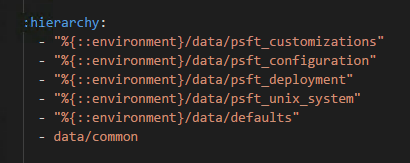Since the Deployment Packages were released with PeopleTools 8.55, one of my criticisms has been that the DPK is a bit of a sledgehammer. If you define multiple PeopleSoft environments on a server and you want to configure one web server, ALL the domains that the DPK knows about are shut down.
Puppet has an Environments feature that lets you segregate your code and data. While the DPK does not support Puppet Environments out of the box, we can use them to make the DPK less of a sledgehammer when managing our domains. (There is still some sledgehammering going on, so go vote for this idea).
While environments let you separate the modules, manifests and data folder, in this post we’ll separate just the data folder. This will let us share a common set of code (the manifests and modules folders) but the configuration of each domain will be different.
If you want to extend this to the modules and manifests folder, copy those into the environment folders with the environment-specific changes. This is useful for testing new code changes or if you want an environment to use a different DPK Role in the site.pp file.
Create Environment Folders
- Make a new
devandtstfolders underc:\programdata\puppetlabs\puppet\etc\environments
You can have multiple environments under this folder – as many as you want. A strategy that I’m testing is using the database name as the environment name. For this post, I’ll stick with dev and tst
- Copy your YAML files from
puppet\etc\datatopuppet\etc\environments\dev\dataandpuppet\etc\ environments\tst\data.
Configure Puppet Environment
Under the puppet\etc folder, add (or modify) the puppet.conf file to look like this:
[main]
environment=production
parser=future
environmentpath=c:\programdata\puppetlabs\puppet\etc\environments
hiera_config=c:\programdata\puppetlabs\hiera\etc\hiera.yaml
basemodulepath=c:\programdata\puppetlabs\puppet\etc\modules
This file tells Puppet where to look for your environments, your Hiera configuration, your default module location, and the default Puppet Environment.
Last, we’ll modify the hiera.yaml file in c:\programdata\puppetlabs\hiera\etc to include environments:
---
:backends:
- yaml
:hierarchy:
- "environments/%{::environment}/data/psft_customizations"
- "environments/%{::environment}/data/psft_configuration"
- "environments/%{::environment}/data/psft_deployment"
- "environments/%{::environment}/data/psft_unix_system"
- "environments/%{::environment}/data/defaults"
:yaml:
:datadir: c:\programdata\puppetlabs\puppet\etc
If you want to share some of the files, like the defaults.yaml or the psft_unix_system.yaml file, you could keep those under the main puppet\etc\data folder. Your hiera.yaml file would look like this:
---
:backends:
- yaml
:hierarchy:
- "environments/%{::environment}/data/psft_customizations"
- "environments/%{::environment}/data/psft_configuration"
- "environments/%{::environment}/data/psft_deployment"
- data/psft_unix_system
- data/defaults
:yaml:
:datadir: c:\programdata\puppetlabs\puppet\etc
Test the Environments
Once our Puppet changes are complete we can test some builds. When we run puppet apply, we’ll add an additional paratemer: the environment. To build my dev environment domains, I’ll use this procedure:
cd c:\programdata\puppetlabs\puppet\etc\manifests
puppet apply .\site.pp --environment=dev --debug
Once the dev domains are built and running, you can kick off the tst build with:
puppet apply .\site.pp --environment=tst --debug
As the tst environment is building, your dev domains should stay up and not be affected by the Puppet run. If they are affected, you may have some YAML changes that need to be made. Make sure your configuration’s between the environment don’t overlap (e.g, same PS_CFG_HOME and domain names).

If you make this change and want to keep using the
hieracommand line tool, you’ll need to tell Hiera which environment you are using. To pass in the::environmentfact, do this: